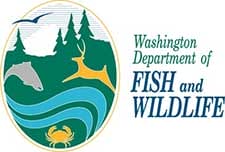

OLYMPIA –-(Ammoland.com)- The Washington Fish and Wildlife Commission removed bald eagles and peregrine falcons from the state list of “sensitive species,” and received public comments on future options for the Columbia River reform policy at a meeting here Dec. 9-10.
The commission, a citizen panel appointed by the governor to set policy for the Washington Department of Fish and Wildlife (WDFW), also adopted nine new saltwater fishing rules that will take effect July 1, 2017.
The commission’s action to reduce the state’s protective status of bald eagles and peregrine falcons reflects the species’ steady recovery since the 1970s, when the pesticide DDT was banned under federal law.
“This has been a long time coming,” Becker said. “Both of these species are success stories in Washington as well as in other states.”
In addition to delisting bald eagles and peregrine falcons, the commission also approved the reclassification of three other wildlife species. White pelicans were reduced from “endangered” to “threatened” status, while marbled murrelets and lynx were reclassified as “endangered” due primarily to the continuing loss of essential habitat.
More information is available on all of these species on the department’s website.
The second day of the meeting was largely dedicated to a public discussion about the next phase of the commission’s Columbia River reform policy, adopted in 2013 to restructure salmon fisheries below Bonneville Dam.
Developed in conjunction with Oregon, the policy is designed to promote conservation of salmon and steelhead, prioritize recreational salmon fishing in the lower Columbia River, and transition gillnet fisheries into off-channel areas. The policy also calls for increasing hatchery releases in these areas, while expanding commercial fishing opportunities through the use of alternative fishing gear.
With the transition period of the reform policy set to end this year, the commission heard comments from more than two-dozen recreational and commercial fishers on options for implementing the next phase of that plan. Initial options under consideration by the commission would:
- Extend the transition period of current plan.
- Adopt the Oregon Department of Fish and Wildlife staff proposal for “rebalancing” commercial and recreational benefits for spring and summer chinook salmon.
- Follow the current policy, which would end the transition period Dec. 31, 2016.
Following public testimony, the commission asked WDFW staff to provide an economic analysis of each option and to analyze an additional option that would explicitly allow a gillnet fishery for upriver bright fall chinook upstream from the Lewis River in 2017 and 2018.
Options currently under consideration are posted on WDFW’s website. The commission will accept written comments on those and other proposals through Jan. 6, and will also invite public testimony at a public meeting Jan. 13-14 in Vancouver, Wash., before considering any updates to the policy.
Other issues addressed by the commission during its two-day meeting include:
- Saltwater sportfishing rules: The commission approved nine saltwater sportfishing rules for the 2017 season, including one that requires vessels fishing for bottomfish or halibut in Puget Sound to carry a descending device to enable anglers to safely return rockfish to deep water. All new fishing rules are posted on WDFW’s website at http://wdfw.wa.gov/fishing/regulations/rule_proposals/2017-2018/recommend.php.
- Land transactions: The commission approved two land transactions by WDFW, one of which would add 40 acres in Cowlitz County west of Merrill Lake to the Mount St. Helens Wildlife area. The commission also approved a right-of-way exchange with Clallam County to support an estuarine restoration project near the mouth of Dungeness Bay.
- Conservation initiative: The commission also discussed a draft policy that supports state and national efforts to find additional funding sources for fish and wildlife species that are typically not fished or hunted. The funding could be used to support the state’s Wildlife Action Plan, designed to conserve Washington’s diverse fish and wildlife and their habitats.
